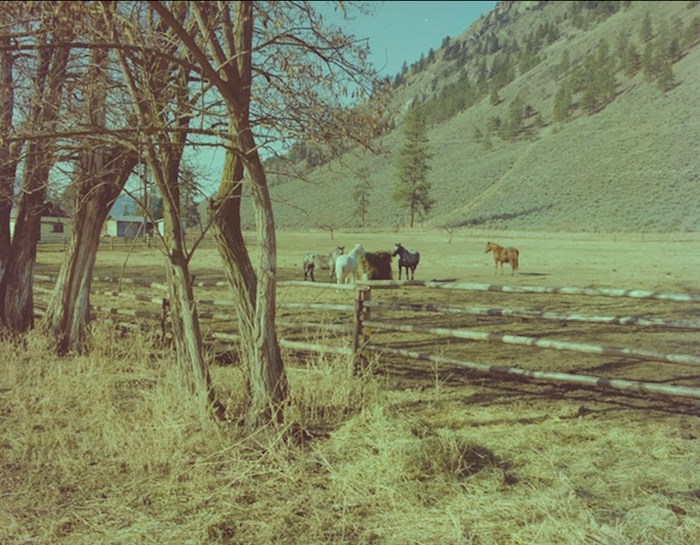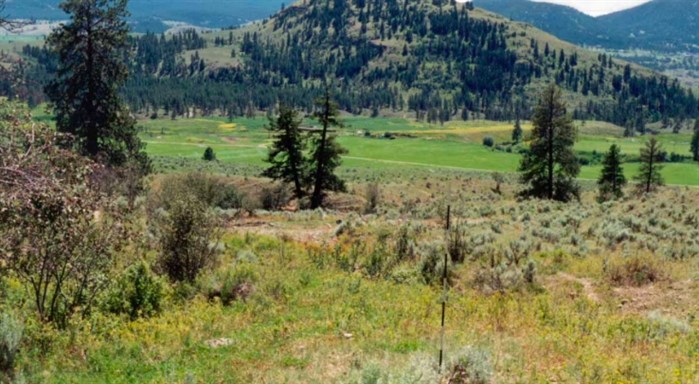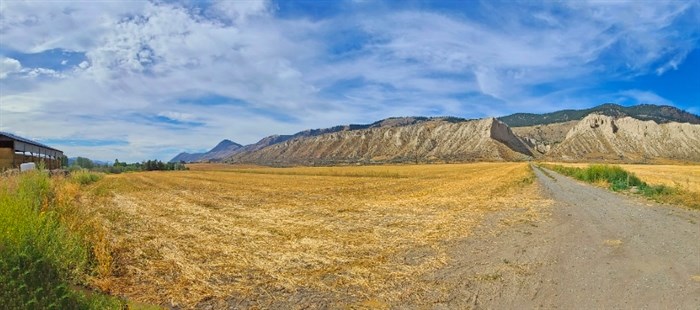
The Harper Ranch some time between 1977 and 1983.
Image Credit: Submitted/Royal BC Museum
July 16, 2023 - 6:00 AM
The Harper brothers set up a ranching operation on the north shore of the South Thompson river in 1862 on their way to making a fortune driving cattle to Barkerville.
Their cattle brand is the oldest one still in use in Canada and Thaddeus Harper eventually bought and built the massive Gang Ranch in the Chilcotin.
But he also ran roughshod over what was then known as the Kamloops Band (now Tk'emlups te Secwepemc) in his drive to irrigate the Harper Ranch near Kamloops.
“Kamloops Natives faced the encroachment of a large ranching company, which had purchased some 8,900 acres of land, much of it to the east of the reserve on upper Paul Creek,” according to an article called: 'White Man Has No Right to Take Any of It: Secwepemc Water Rights Struggles in BC,' written by Kenichi Matsui and posted on the Johns Hopkins University’s Project Muse website.
The article focuses on the decades-long disputes over water access.
“In 1882, the owner of the company, Thaddeus Harper, applied for 250 inches of water to irrigate his large pasture, known as Harper’s Meadow. This pasture had been part of the Secwepemc territory assigned by (assistant Commissioner of Lands) William Cox. Employing large gangs of men, Harper started constructing irrigation ditches to divert water from Paul Creek.
“In 1886, as part of his irrigation works, he lowered the outlet of Paul Lake, from which Paul Creek drains, with the objective of increasing the water discharge to his ditches. The Kamloops people persistently resisted Harper’s effort to control water in Paul Creek.”
READ MORE: iN PHOTOS: Treasure trove of historical depictions of life from Kamloops to Osoyoos
But, it seems, Harper mostly got his way, until he lost it all in the end.
Thaddeus Harper was born in Harper’s Ferry, West Virginia in 1829. When the American Civil War broke out in 1858 he and his brother Jerome, who was about three years older, headed north.
The next year they started the first sawmill in BC near Yale, did some mining and farming.
But when the Cariboo gold rush took off in 1862 they got into the cattle business big time, driving cattle from the U.S. up the Okanagan Trail to Kamloops.

Image Credit: Submitted/Province of BC
“Their first selection of a permanent site was a few miles east of Kamloops, on the South Thompson, and still known as the Harper Ranch, says an article in Canadian Cattlemen written by J.W.G. MacEwan, likely in 1947.
That’s where the cattle brand was established. Most versions say it stands for Jerome Harper.
“The brand represents the two founder's initials, Jerome and Thaddeus Harper,” says an article on the Douglas Lake Ranch website. “The J stands for Jerome and the sideways T stands for Thaddeus. Connected they form an H for Harper.”
In 1863 they negotiated with a Chilcotin First Nation man named Kalalest to use land on the west side of the Fraser River and established what is now known as the Home Ranch.
The first Crown grant application was for 160 acres of land. Eventually the holdings grew to almost 38,500 acres, including Harper’s Ranch near Kamloops and the Perry Ranch near Cache Creek.
There is some mystery surrounding the Gang Ranch name. Some versions say it was because they employed large gangs of men while others credit them as being one of the first ranches to use a gang plow.
At the same time as they were expanding operations in the Chilcotin, they were taking water from the Secwepemc in Kamloops.
“They were outraged to learn that Harper had lowered the outlet of Paul Lake,” the Matsui article says. “A number of men from the reservation tried unsuccessfully to fill the cut.”
In 1888, after the ranch was sold to the Western Canadian Ranching Company, the dispute heated up again.
“When the company attempted to increase the storage capacity of the lake by raising the height of its dam in the late 1890s to remedy the shortage of water supply in the creek, the Natives again attempted to stop the construction,” Matsui wrote. “At one point, Secwepemc men confronted the company’s employees with rifles to stop the project.”
Over the years, the Department of Indian Affairs tried to turn the Secwepemc into farmers and they built their own irrigation ditches. But the cattle company also tried to work with them on water rights in order to increase their grazing area.
By the end of the 1940s, the irrigation works had fallen into disuse.
READ MORE: The long history of paddle wheelers between Kamloops and Enderby
The Harper brothers also did not fare well, both getting kicked in the face by horses.
Jerome was kicked in 1870 and retired to San Francisco where there were reports that he was “hopelessly insane.” He died in Santa Barbara in 1874.
That left Thaddeus with a $150,000 inheritance and all of Jerome’s land.

Image Credit: Submitted/Thompson Nicola Regional District
“Things went well as long as the market was good at the gold mines but the demand had fallen away seriously by 1870,” MacEwan wrote. “By 1878, the Harper cattle on the inter-Mountain ranges had become so numerous and the market so limited that Harper made up his mind that he had everything to gain and nothing to lose by gambling on a long and hazardous drive.”
Rather than settle for $15 a head in BC, he decided to drive a herd to Chicago with the expectation of netting $40 a head after the cost of driving the cattle and shipping them the final distance by train.
He started with a herd of 800 and picked up 400 more before overwintering in Washington.
By the spring of 1878, the Chicago market had fallen but a drought had devastated California so he changed direction and netted $70 a head in San Francisco.
But the good times were not to last long.
“Thaddeus eventually started experiencing financial hardships and sold the Hat Creek Ranch property in 1881,” MacEwan wrote. “After a severe winter in 1887, in an unsuccessful attempt to avoid personal bankruptcy Thaddeus sold the Gang Ranch in 1888 to his partners in the Western Canadian Ranching Company. The sale included ranch land at Canoe Creek, Clinton, Kamloops, and the Perry Ranch at Cache Creek.
“Thaddeus Harper would go on to pursue opportunities in the mining industry, until 1889. While out riding alone, Thaddeus Harper suffered a fall from his horse and was kicked in the face. He was found unconscious a day later and spent six weeks in the hospital in Victoria. Thaddeus Harper died in Victoria on December 9, 1889 at the age of 65.”
The Western Canadian Ranching Company sold the Harper Ranch in 1947.
READ MORE: Tk'emlups healing centre to be built on former Harper Ranch property
“After various families briefly owned the Harper ranch during the latter half of the twentieth century, the Kamloops Band purchased 44,000 acres of the ranch for $6.9 million in 1988,” Matsui wrote.
This spring, Tk'emlups te Secwepemc announced plans to build a healing centre on one part of the Harper Ranch.
To contact a reporter for this story, email Rob Munro or call 250-808-0143 or email the editor. You can also submit photos, videos or news tips to the newsroom and be entered to win a monthly prize draw.
We welcome your comments and opinions on our stories but play nice. We won't censor or delete comments unless they contain off-topic statements or links, unnecessary vulgarity, false facts, spam or obviously fake profiles. If you have any concerns about what you see in comments, email the editor in the link above. SUBSCRIBE to our awesome newsletter here.
News from © iNFOnews, 2023